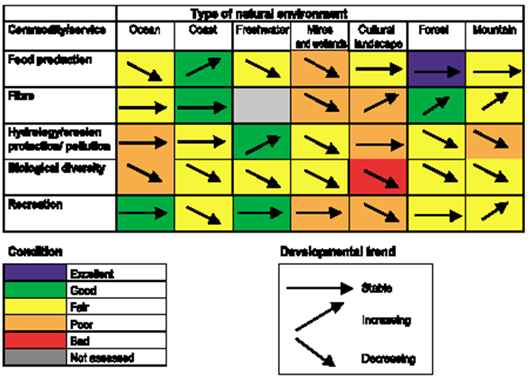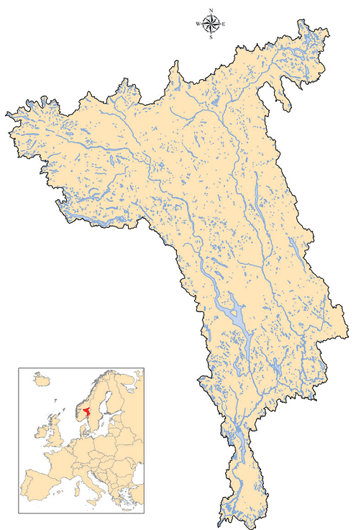Norway
Glomma river basin study
Contact Information
- Signe Nybø
Directorate for Nature Management
signe.nybo@dirrat.no
Tungasletta 2
N-7485 Trondheim
Norway
- Odd Terje Sandlund
Norwegian Institute for Nature Research
odd.t.sandlund@nina.no
Tungasletta 2
N-7485 Trondheim
Norway
Project Team and Institutions
The pilot study was conducted by Signe Nybø of the Directorate for
Nature Management and Odd Terje Sandlund of the Norwegian Institute for
Nature Research. The scenario project on Østfold was conducted by Bjørn
Åge Tømmerås and Hanne Svarstad of the Norwegian Institute for Nature
Research.
The pilot study was funded by the Ministry of Environment of Norway,
while the scenario project was funded by the Nordic Council of
Ministers.
The intended audience for this assessment is national and regional
decision-makers.
Timeframe
Conditions and trends were assessed from 1900–2000, with time scales
differing among services investigated. The scenarios were projected
until 2025. The conditions and trends assessment was completed February
2002, while the scenario project was completed in September 2004.
Project Summary and Results

The pilot study led to a decision to undertake a full-scale study.
The pilot study consisted of three main parts: (1) proposals for the
focus and organization of a full scale study, (2) a survey of Norway’s
natural environment and its ecosystem services, and (3) a case study
from the Glomma river basin. Glomma is the largest river in Norway. The
pilot study concluded that Norway had both the data and the capacity to
undertake the full-scale study; and also that several sectors had an
interest in being involved in the process. However, funding for the
full-scale study was never secured; reported here are the results of
parts 2 and 3.
Survey of Norway’s natural environment and ecosystem services . This
part of the pilot study comprises a simplified analysis of the condition
of, and trends in, values and services associated with Norway’s natural
environment. The study compares the current status with the situation as
it was about a hundred years ago. The analyses were conducted
individually for each ecosystem. As a result, it was not immediately
possible to compare results from the different ecosystems to each other.

Glomma and Lågen River Basins
The Glomma river basin study
The Glomma case study demonstrates how data series from diverse
social sectors and activities can be used to analyze the way in which
the extraction of products and services from ecosystems simultaneously
depends upon, and exerts influence on, the condition of the ecosystems.
The demands of one sector for extraction of services can influence the
potential for extraction desired by other sectors. The Glomma river
basin exemplifies many of the opposing interests, conflicts and
necessary compromises faced by those involved in nature management. Some
examples are:
- Infrastructural development leads to the fragmentation of the
landscape. There is information to show that this has a negative
effect on species such as wild reindeer, but information on the
other effects of such fragmentation is largely lacking. In the
Glomma river basin, the areas south of the line
Trysil—Elverum—Hamar—Gjøvik are today devoid of encroachment-free
areas, and in the areas north of this line the encroachment- free
areas largely coincide with existing or planned conservation areas.
- The areas of old-growth forest have diminished, while at the
same time the forests contain a larger volume of timber and have a
different structure than they had fifty years ago. This management
of forest resources aimed at lumber production has probably led to
the loss of biological diversity at the species or ecosystem level.
- Economic and political conditions at national and international
levels promote changes in farming methods. Larger areas of
uninterrupted fields and fewer field boundaries and groves provide
for more efficient food production. Changes in the cultural
landscape have consequences for tourism and outdoor pursuits in
terms of experience and enjoyment value. The homogenization of the
landscape can be detrimental to the tourist industry.
- Along the coast, conflicts of interest continually arise between
the construction of holiday cottages or other infrastructure, and
the public’s rights of access to land and sea. This problem also
arises along the coast near the mouth of the Glomma.
- The watercourse today supplies diverse services and products
such as hydro-electricity, supply of water to households and
irrigation, cleansing of drainage water and recreation. Future
conflict between different user interests on the watercourse will
probably occur in different combinations in each individual case.
Scenarios
Three scenarios were developed for the Glomma river outlets. The bush
encroachment scenario and the urban growth scenario reflect the ways in
which current trends along these two paths might play out if they are
dominant toward the year 2025. The third scenario provides a contrast in
which both of the two sets of trends have been avoided by various
political actions. The study was carried out as a cross-disciplinary
collaboration based on ecology and sociology.